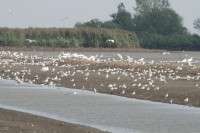Targeted action needed to protect waterbirds

(Phys.org) —Researchers from our Biodiversity Lab have identified specific areas around the world where conservation efforts could best be targeted to safeguard inland-breeding waterbirds.
In their new report, the first ever global study of its kind, Laura Williamson and Professor Tamás Székely, analysed data from 471 species of birds, focusing on waterbird species which breed in inland wetlands. These inland wetland habitats are important breeding grounds for birds and are strongly affected by human activities.
Waterbirds make up around 10 per cent of all bird species and are an important indicator for the health of a wetland ecosystem, including lakes, streams and rivers. The main threats to waterbirds are from habitat loss, primarily caused by human activities such as land reclamation and development, agriculture, pollution, transportation and energy production.
Their report identifies East Africa as having the highest diversity of waterbirds, but pinpoints coastal China as the location with the greatest numbers of threatened waterbirds listed on the IUCN Red List of Threatened Species. The orders with the highest proportion of threatened species include grebes, cranes and storks.
By comparing the locations of protected areas with the number of species, this study found that more targeted conservation efforts are required. Whilst areas in Europe and Brazil were generally well protected, India, China, Argentina, Uruguay, Kazakhstan, Central America and Africa are in need of further protection for wetlands and waterbirds.
Commenting on the main findings of the report, Laura Williamson said: "What we see is that in many sites across the world where waterbirds are most diverse, the conservation measures are unfortunately weakest.
"This global study highlights sites of critical importance for the greatest number of waterbird species possible. Focusing conservation effort in these areas will allow the greatest beneficial impact from limited conservation resources."
Whilst efforts have been made in recent years to protect migratory waterbirds and their migratory path or 'flyway', there has been less focus on non-migratory waterbirds, which are often under-represented in conservation plans.
Professor Tamás Székely added: "Wetlands are providing essential services for humankind, nevertheless, they are disappearing at an alarming rate. Many countries have lost over 50 per cent of their natural wetlands, and the remaining wetlands are often struggling for survival. Our study highlights the need for more substantial conservation efforts to secure long-term viability of the remaining wetland habitats worldwide."
More information: link.springer.com/article/10.1007%2Fs10531-013-0488-2
Provided by University of Bath


















